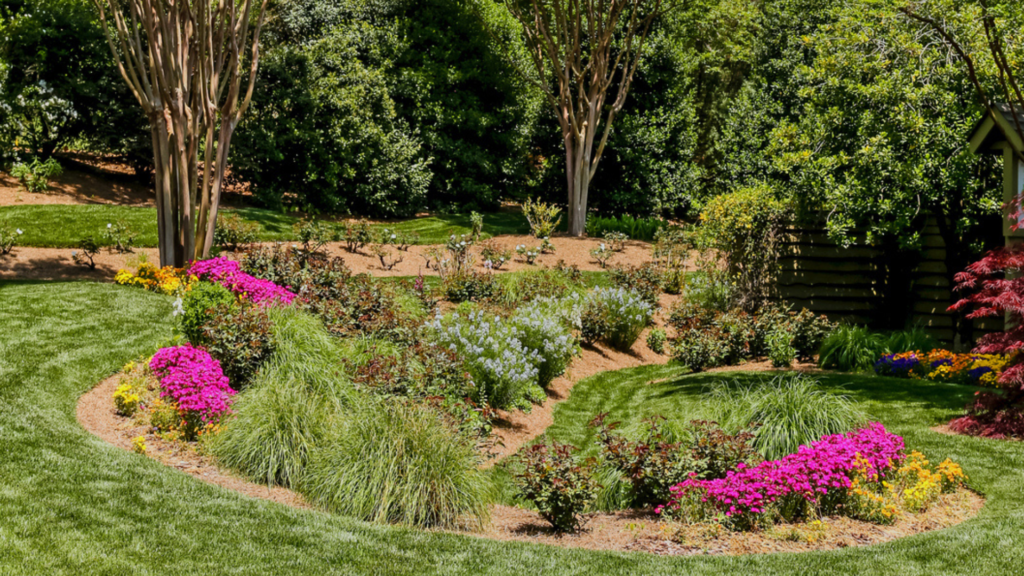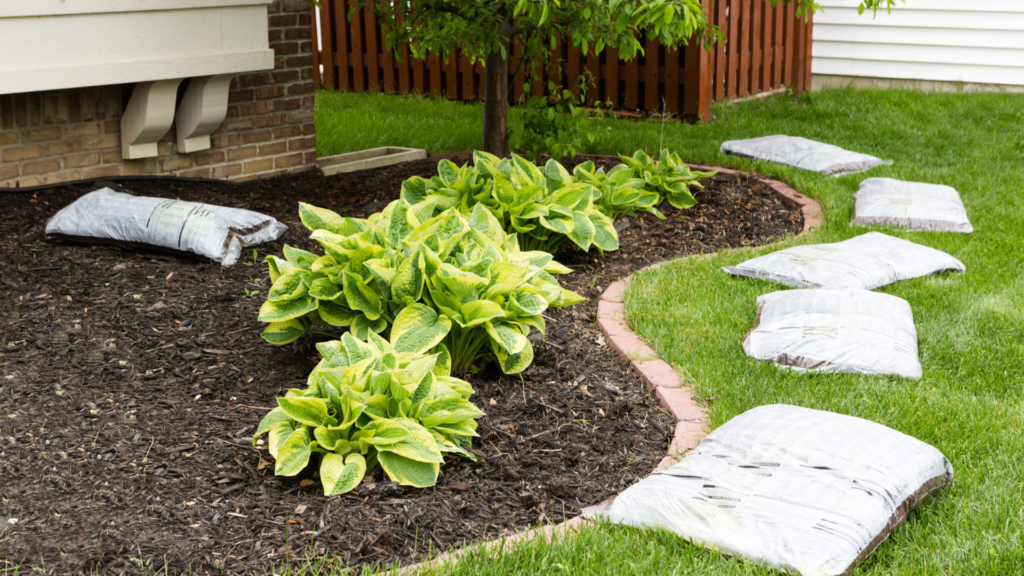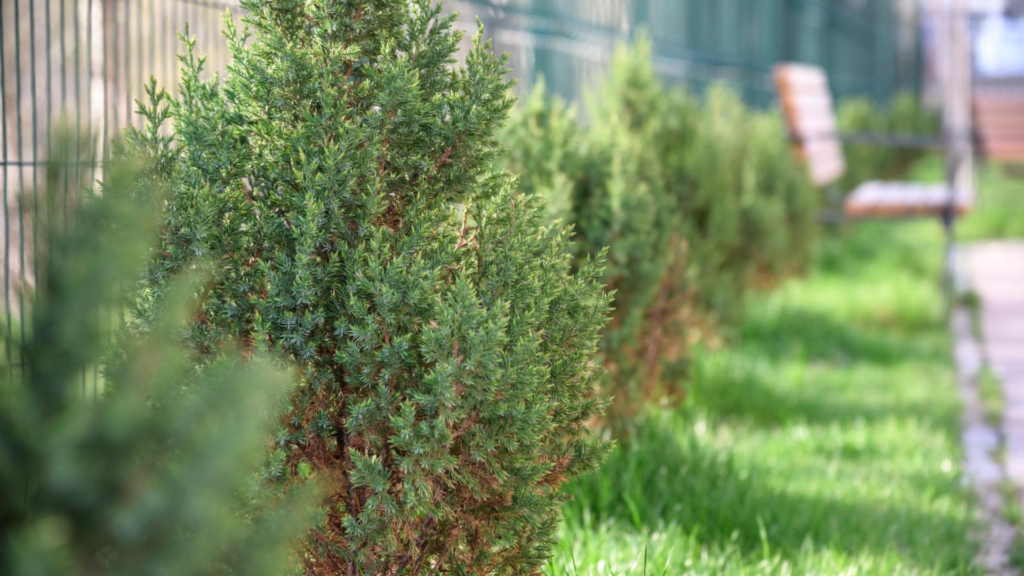A sloped backyard can be a headache. It’s difficult to landscape, tricky to maintain, and can cause serious soil erosion issues.
If you’ve got a sloped garden or you’ve noticed your soil depletes quickly in the rain and wind, this post is for you.
We’ll show you 11 effective erosion control landscaping strategies that can transform your garden from a mud slick to an Eden, no matter your budget.
Table of Contents
What is Erosion Control Landscaping?
Erosion control landscaping uses specific techniques to prevent soil erosion on properties. Techniques include plants, irrigation systems, and barriers such as rocks and mulch to stabilize soil and prevent erosion. The goal of erosion control landscaping is to protect the soil, water quality, and property from the damaging effects of erosion.
What is Erosion & What Causes It?
Soil erosion is a geological process where the earth is worn away or transported to other areas by the elements. Most landscape erosion occurs because of water, wind, or ice, but in our gardens, it’s usually heavy rain and harsh winds causing the damage.
If you have a sloped landscape, hillside erosion can happen much more quickly, which is why it’s important to take preventative measures.
Why is Controlling Erosion Important?

Controlling erosion is important to maintain the soil quality in our gardens. When rainfall and wind erodes the earth, important nutrients and ecosystems go with it, leaving us with barren soil.
Not only does it cause long-term damage to the soil, but it can also be dangerous. If you have significant slopes on your property, erosion is potentially threatening to trees, established shrubs, and landscape architecture.
To protect our plants, our homes, and the ecosystems in our gardens, erosion control is key.
Erosion Control Solutions
Not all erosion control solutions are suitable for all gardens, so we’ve put together a list of 11 effective methods for you to choose from.
Planting vegetation
Planting trees, shrubs, and other plants is one of the most effective and affordable ways to prevent erosion. Plants absorb excess water and stabilize the soil, reducing the force of rainwater and wind.
If you’ve got a steep slope, you’ll need larger plants with deep roots to hold in place and redirect rainwater. Plant a line of shrubs or trees parallel to a hill to help disperse rainwater and prevent mudslides that can quickly lead to erosion.
Some great shrubs for erosion control are:
- Forsythia
- Boxwoods
- Hydrangea
- Red maples
- Blue Point juniper
However, try to choose native plants that won’t become invasive in your garden. Native species always do the best in local climate conditions, meaning you’ll quickly have a thriving landscape.
Mulching

For smaller areas and mild slopes, mulching is a quick and effective method to help prevent water erosion. Organic materials, such as leaves or straw, help bind the surface of the soil and prevent waterlogging.
If your garden has less than a 33% gradient, it will benefit from a layer of mulch ground cover. But it can also be beneficial around new trees and shrubs to lock in those important nutrients.
Terracing
If you need a faster solution, terracing is a great defense against soil erosion. Build a series of flat steps into a slope to slow down the flow of water and prevent soil from washing away.
Terracing is especially useful if you have a series of slopes or hilly terrain that gets slick with mud during rainfall. Although plants, shrubs, and trees will work in time, terracing is a much faster solution.
Terracing can be made from almost anything, from wood to concrete blocks. You could also add flower beds around the terracing to provide sanctuaries for wildlife and much-needed greenery around the hardscaping.
Retaining walls
A retaining wall is a purpose-built structure that holds back soil and prevents erosion. These are usually made from stone or concrete and act as anchors for the soil. Properly designed retaining walls also have drainage that effectively channels surface runoff, further helping keep the soil intact.
Riprap
Riprap is loose stone that you often see along shorelines, hillsides, and roadsides for sediment control. In areas where wind, rain, or the ocean has a significant impact on the nearby soil, riprap is an effective and affordable way to redirect floodwaters without the need to build a real wall.
If you’ve got areas of your property where vegetation can’t grow and you don’t want to invest in a wall, riprap could be a good alternative. It works on moderate slopes and naturally becomes a hub of wildlife if left undisturbed.
Gabions
These are wire baskets filled with large rocks and similar materials, often used to stabilize river banks and slopes. Although they’re not often used in gardens, they’re a great solution for commercial spaces since they’re easy to place and provide an extremely strong barrier against erosion.
Erosion control blankets
Specialist blankets made from straw, coconut fibers, or jute can be used to cover the soil and protect it from rainfall and wind. Most are biodegradable and are held together by a fiber mesh.
Since they degrade slowly, they allow vegetation to slowly grow underneath them, which can eventually take over the job of erosion control landscaping.
An erosion control blanket also provides key nutrients for the soil, similar to mulch. If you have areas where germination is a challenge, erosion control blankets could be the best solution.
Bioengineering techniques
This involves using living plants and materials to stabilize slopes and prevent erosion. Some popular techniques include installing live willow stakes and woven branch mats.
Bundles of live willow staked in small trenches dug alongside a slope. When they establish, they trap eroding soil and absorb excess water. Although this is a slow technique, it’s sustainable and great for small gardens.
Stormwater management
If you live in an area with frequent flooding and storms, management is key. Figure out where the water naturally runs over your garden, and create diversions to channel excess water down the slop along a set path.
The simplest way to do this is to create open ditches by digging along the length of the slope. However, you can also use pipes and gutters for a more streamlined finish.
Soil stabilization
If your garden has loose soil, you could also think about soil stabilization. Adding materials such as lime, cement, or other binders to soil can help to stabilize it and prevent erosion.
This creates a more dense substrate that isn’t as susceptible to erosion. Although this is tough to do over large areas, it’s an effective solution for small flower beds and borders. Just make sure you don’t create overly acidic or alkaline soil that kills off your plants!
Best Types of Plants for Erosion Control

There are specific erosion control plants (ECPs), ornamental grasses, and turfs that work wonders against erosion. If you don’t have the money to invest in terracing or you don’t like the idea of digging trenches, you could try from ECPs.
Standard turfgrass alone can lower the rate of erosion on low-to-moderate slopes, but deep-rooted grasses and plants are needed for steeper slopes.
Here are some of the best plants for erosion control landscaping:
- Ornamental grasses
- Fescue grasses
- Ryegrass
- Catmint
- Groundcover roses
- Creeping juniper
- Wildflowers
Although these are great options, a low-maintenance, native species is your best option. Find plants native to your area that require minimal watering and find something that can thrive and grow thickly in your climate.
How Do You Prevent Erosion on an Extremely Sloped Yard?
First, you need to figure out the slope of your landscape. The National Resources Conservation Service (NRCS) provides three categories to help:
- Low: less than 33% slope
- Medium: between 33% and 50% slope
- High: more than 50% slope
Once you’ve figured out the incline of your slope, here are some suggestions for the best type of erosion control landscaping for your garden:
- Low: mulch, groundcover plants
- Medium: irrigation, erosion-control blanket, deep-rooted vegetation
- High: riprap, terracing, retaining wall
What is the Cheapest Erosion Control?
If you’re on a budget, the cheapest soil erosion control service is planting vegetation. You can get extremely cheap seeds for shrubs, ground-covering plants, and even turf to help stabilize soil and stop erosion.
The drawback is the time it takes for vegetation to establish. It can be months before vegetation has grown enough to have an effect on the soil. Even so, it’s cost-effective, environmentally friendly, and requires minimal maintenance.
Final Thoughts
Soil erosion can be such a headache for gardeners, especially those looking to grow flowers and vegetables. Without proper erosion control landscaping, you’ll quickly find your soil isn’t nutrient-rich or stable enough for plants to thrive.
Luckily, there are plenty of control strategies to prevent erosion and keep your soil as healthy as possible. Start by figuring out which methods will work best for your landscape, and you’ll notice a significant difference in no time.

